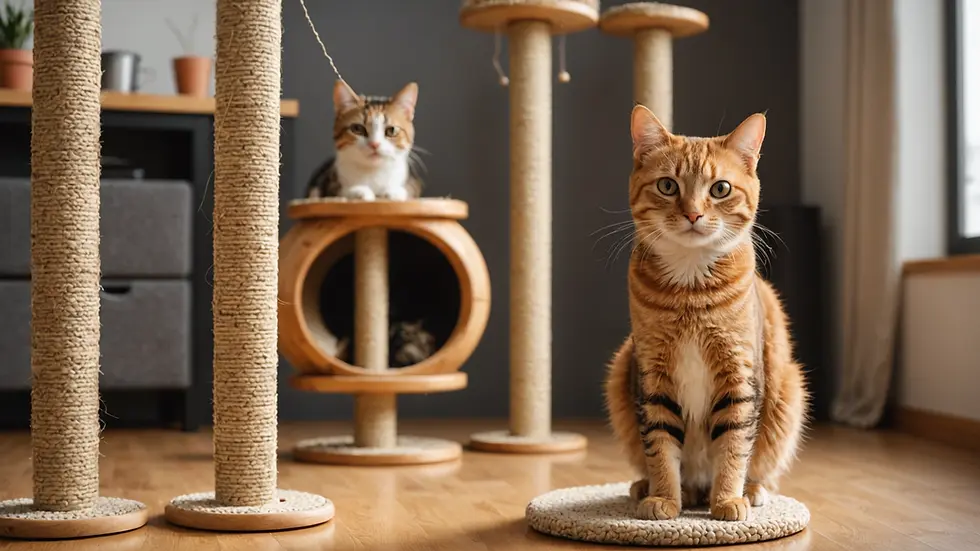Why Some Veterinarians Advise Against Declawing Cats - Exploring the Potential Risks and Alternatives
- Jyotiraj Borah
- Feb 5
- 4 min read
Declawing cats has sparked heated discussions in veterinary practices, among pet owners, and within animal welfare circles. While it may appear to be an easy fix for protecting furniture and belongings, understanding the full impact of declawing is essential. This post will explore the reasons veterinarians caution against this procedure, the physical and behavioral risks it poses, and effective alternatives that respect the well-being of our feline friends.
Understanding Declawing: A Brief Overview
Declawing goes beyond removing a cat's claws; it involves amputating the last bone of each toe. This painful surgery can lead to both immediate and prolonged distress for cats. In fact, studies show that up to 68% of declawed cats experience pain-related issues after the procedure.
Many pet owners consider declawing to prevent scratching of furniture or people. However, the consequences of this decision can be significant, impacting not only the cat's physical health but also their emotional well-being.
The Physical Risks of Declawing
Pain and Recovery
The immediate pain related to declawing is substantial. Even with pain medications, cats can experience discomfort and swelling in their paws. The recovery may take weeks, during which time they often struggle with activities like walking, climbing, or playing. For agile creatures like cats, altering their mobility can lead to frustration that could manifest as behavioral problems.
Changes in Behavior
Behavioral alterations are a common aftermath of declawing. Research indicates that 50% of declawed cats might show anxiety or aggression, especially if they feel threatened without their claws for self-defense. Behavioral issues such as biting can increase when cats are unable to express themselves through their natural behaviors.
Additionally, many declawed cats develop litter box aversions. A study found that nearly 30% of declawed cats avoided using the litter box due to discomfort with the litter's texture. This issue not only affects the cat but can also strain the relationship between pet and owner.
Long-Term Effects
Declawing can lead to chronic health issues. The alteration of a cat's anatomy can result in joint problems, and studies have shown that declawed cats are more prone to developing arthritis later in life. These long-term effects can significantly diminish a cat's quality of life.

The Ethical Considerations
Animal Welfare Concerns
The ethical implications of declawing are significant. Major animal welfare organizations, including the American Veterinary Medical Association (AVMA), strongly oppose the practice unless absolutely necessary. They emphasize the importance of opting for humane alternatives whenever possible.
Pet ownership carries the duty to prioritize the welfare of animals. Choosing an irreversible procedure that inflicts suffering poses ethical questions about our responsibilities toward our pets.
Legislative Actions
Growing awareness around declawing has led to legislative measures in several states and countries. In California, for example, the practice has been banned altogether, reflecting a shift toward protecting pets from unnecessary pain. Pet owners should be aware of these legal measures and consider the moral implications of their choices.
Alternatives to Declawing
Nail Trimming and Clipping
Regular nail trimming is an effective way to minimize scratching damage. By keeping the claws short, owners can reduce the chances of furniture and belongings being scratched. Many veterinarians recommend routine grooming sessions about every 2-4 weeks to maintain optimal claw length.
Providing Scratching Posts
Offering various scratching surfaces can satisfy a cat's instinctual need to scratch. Studies suggest that cats are more likely to use available scratching posts if they are placed in prominent locations. A range of materials—like sisal, cardboard, and carpet—can cater to different feline preferences. Providing multiple scratching options can protect household items while keeping cats happy.

Training and Behavior Modification
Training methods can also help manage unwanted scratching. Positive reinforcement, such as rewarding cats when they use scratching posts, can encourage appropriate behaviors. Additionally, calming products like pheromone diffusers can create a soothing atmosphere that reduces stress-related scratching.
Understanding Cat Behavior
Feline Communication
Cats scratch not just to groom their claws but also as a way to communicate and establish territory. Recognizing this behavior as a natural instinct helps cat owners manage scratching in a more understanding and effective manner.
Early Socialization
Proper socialization from a young age reduces the likelihood of destructive behaviors later on. Introducing kittens to various people, environments, and other animals fosters good habits, leading to more adaptable and well-adjusted adult cats.
Environmental Enrichment
Creating an engaging environment is vital for a cat's happiness. Providing toys, climbing opportunities, and interactive playtime can keep a cat stimulated. A mentally satisfied cat is less likely to display frustration through destructive behaviors.
Consulting with a Veterinarian
Individual Assessment
Before making decisions regarding a cat's claws or behavior, it is essential to consult a veterinarian. Each cat has unique needs, and a professional can provide tailored recommendations that consider both physical and behavioral aspects of scratching.
Understanding Risks
Discussing declawing with a veterinarian can raise awareness of its associated risks and complications. Armed with knowledge, pet owners can explore alternative strategies for managing scratching while ensuring their cat's health and happiness.
Reassessing Pet Ownership Responsibilities
Declawing may seem like a straightforward solution for managing scratching, but its physical, emotional, and ethical consequences call for a more compassionate approach. Educating ourselves about the risks of declawing and embracing alternative methods is crucial for nurturing our feline companions.
By prioritizing humane strategies—like regular nail clipping, providing appropriate scratching surfaces, and focusing on training—pet owners can create a loving environment that respects the natural behaviors of cats. Ultimately, caring for our pets requires us to consider their health, happiness, and dignity above all else.





Comments